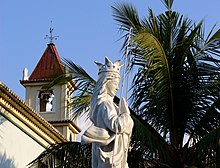Balide
| Balide | |||

|
|||
|
|
|||

|
|||
Balide is a district of the East Timorese capital Dili . "Balidi" means " star fruit tree " in Mambai .
geography

Balide is divided between the Suco Mascarenhas (Administration Office Vera Cruz ) and the Suco Santa Cruz (Administration Office Nain Feto ). Some cards extend Balide to the Suco Vila Verde (Vera Cruz). Others refer to this area as Mata Doro .
The area in Vila Verde extends to the Tunalaran district. To the north, Av. Mouzinho de Albuquerque the border to the Bispo Medeiros district and in the south, beyond the settlement limit, are the Dilis hills. Mascarenhas include the Aldeias Alto Balide and Baixo Balide . To the east of Avenida Francisco do Amaral (formerly Av. Bispo Medeiros ), Balide belongs to Santa Cruz and is to the east by Av. Audian and bounded to the south by the Estrada de Lecidere .
The part of Balide that belongs to Santa Cruz is home to the Church of the Conception of the Virgin Mary in Balide , the Colégio de São José , the Seminário Maior de Balide , the São Luís Primary School ( Escola Primaria Katolica Balide ) and the Escola Portuguesa Ruy Cinatti . In the part that belongs to Mascarenhas there is a primary school ( Escola Kristal Balide ), the Escola Secundária nº4 de Balide , the Convento das Madres Canussianas , the secondary school Ensino Secundário Cristal and the Universidade de Díli (UNDIL).
history
In Balide is the former Comarca prison , which dates back to the Portuguese colonial times. Political prisoners were tortured here during the Indonesian occupation. Justino Mota was a prominent inmate . The last inmates were released in September 1999. Under the administration of the UN , the abandoned building was renovated from January 2002 and from February 17, 2003 it became the seat of the Reception, Truth and Reconciliation Commission of East Timor (CAVR). 65 graffiti by East Timorese artists tell of the time of the occupation. The eight solitary confinement cells were left in their original state. There is also a library and documentation center. Since the end of the work of the CAVR, the memorial has been run by the Association of Former Political Prisoners (ASSEPOL).
During the 2006 riots , Canossians ran a refugee camp in their convent.
Individual evidence
- ↑ Geoffrey Hull : The placenames of East Timor , in: Placenames Australia (ANPS): Newsletter of the Australian National Placenames Survey, June 2006, pp. 6 & 7, ( Memento of February 14, 2017 in the Internet Archive ). September 2014.
- ↑ a b Timor-Leste District Atlas version 02, August 2008 ( Memento of the original from December 3, 2011 in the Internet Archive ) Info: The archive link has been inserted automatically and has not yet been checked. Please check the original and archive link according to the instructions and then remove this notice. (PDF; 448 kB)
- ↑ a b City map of Dili ( Memento from June 30, 2007 in the Internet Archive )
- ↑ a b List of polling stations for the parliamentary elections in East Timor 2007 (PDF file; 118 kB)
- ↑ Monika Schlicher: East Timor faces its past , missio 2005, ISSN 1618-6222 , missio-hilft.de , accessed on January 28, 2019.
Coordinates: 8 ° 34 ′ S , 125 ° 34 ′ E

